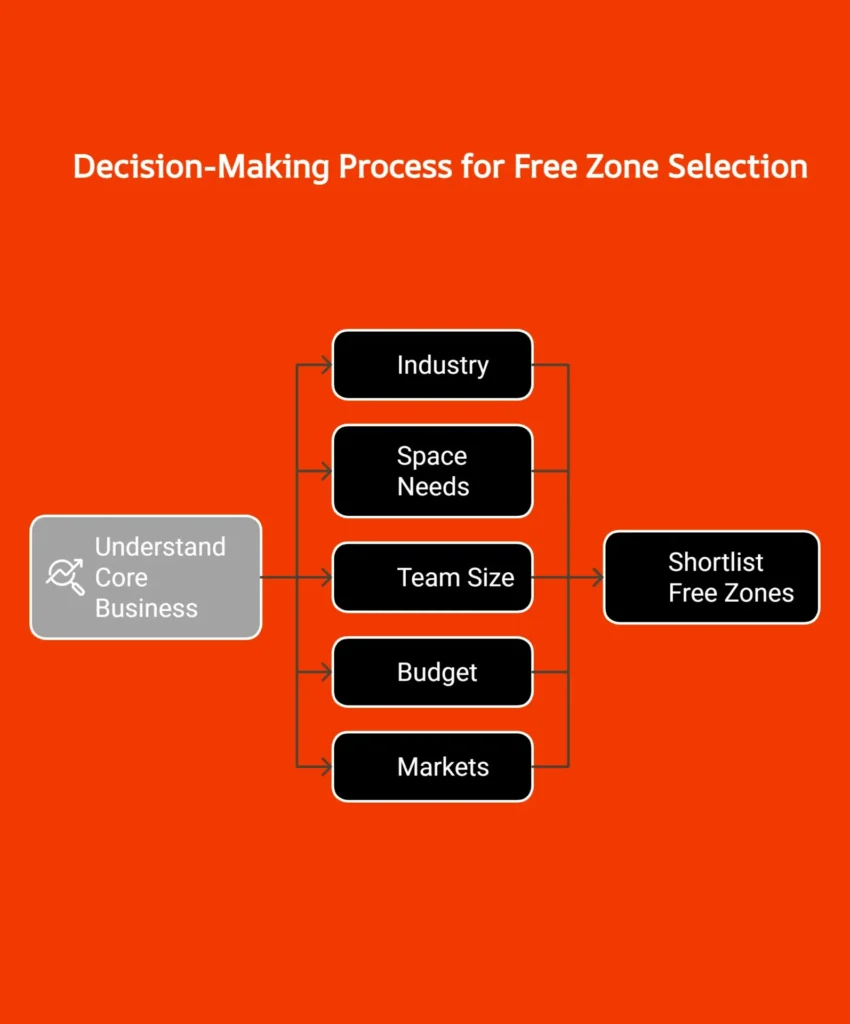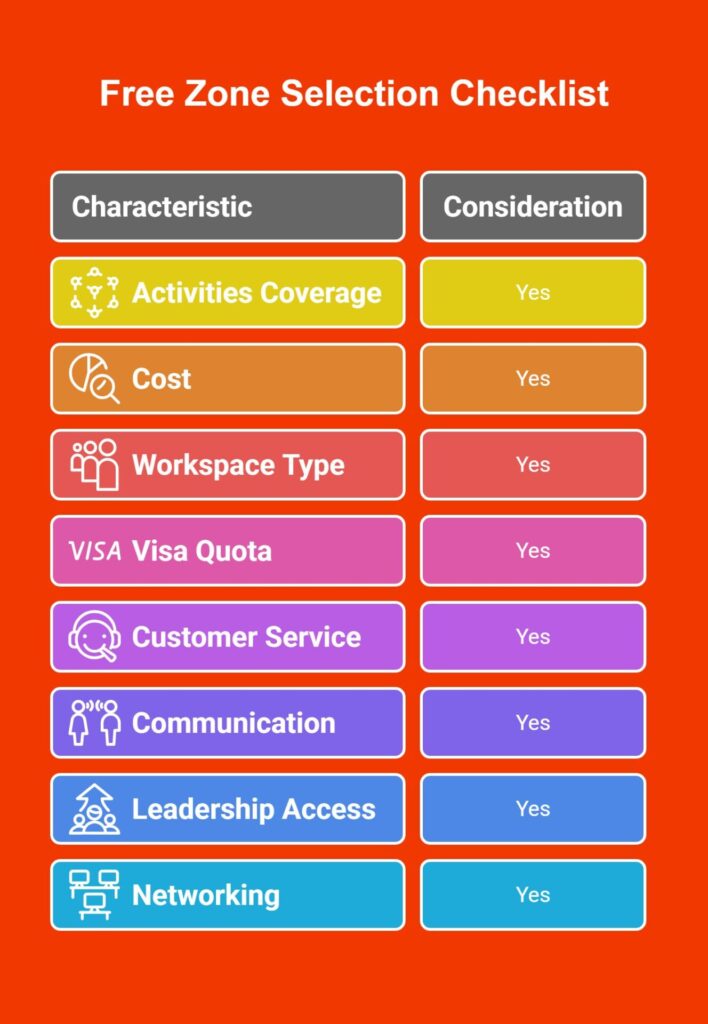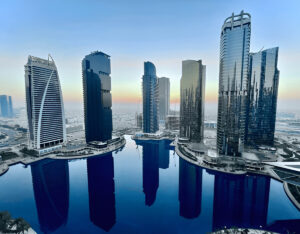Choosing the Right UAE Free Zone
A Detailed Guide to Choosing the Right UAE Free Zone for your Business Activities
-
Pick a zone that fits your industry.
Tech? Go for DIC. Logistics? Choose JAFZA. -
Choose office space that can grow with you.
Start small with a flexi-desk; scale when ready. -
Check the full cost, not just the license.
Watch for hidden fees like visas and renewals. -
Location affects logistics and hiring.
Near ports for trade, cities for talent. -
Look for zones that offer business support.
CRM tools, events, and investor access matter. -
Plan for long-term flexibility.
Pick zones with online portals and upgrade options.
Table of Content
- 1. Why UAE Free zones Matter for Business?
- 2. Key Decision Factors in Selecting Free zone in UAE
- 3. Match Your Business Type to Free Zone Specializations
- 4. Evaluate Budget and Cost Structures
- 5. Define Workspace Needs
- 6. Geographic and Infrastructure Considerations
- 7. Free Zone Comparison Table
- 8. Decision-Making Checklist
- 9. Mistakes to Avoid in Free Zone Selection
- 10. Long-Term Strategic Considerations
1. Why UAE Free zones Matter for Business?
UAE free zones offer 100% foreign ownership, tax benefits, and easy business setup. With over 45 Free zones, each supports specific industries with focused infrastructure and services. Choosing the right one affects your market access, costs, and growth potential.
Free zones like Dubai Internet City (tech) and Jebel Ali Free Zone (logistics) are more than locations, they are business hubs. Your choice impacts trade licensing, operations, and industry networking.
2. Key Decision Factors in Selecting Free zone in UAE
Making an informed decision starts with understanding your core business structure, growth outlook, and operational demands.
Answering the following will give you a clear blueprint for shortlisting most viable free zones:

- Industry: Which sector are you in (e.g., tech, healthcare, trading)? Free zones often specialize by industry, offering sector-specific support, events, and networks.
- Space Needs: Do you need physical premises such as warehouses, labs, or shared office spaceor will a virtual desk suffice? Your workspace requirements influence your licensing type and visa quotas.
- Team Size: What is the current and projected number of employees? Different zones have varying visa allowances tied to office size.
- Budget: What is your total cost allocation for setup and operations? Include less obvious expenses like employee visa costs, license renewals, regulatory fees, and document attestations.
- Markets: Are you targeting UAE residents, neighboring GCC markets, Africa, or global clients and customers? Location impacts logistics, customer access, and proximity to air or sea ports.
3. Match Your Business Type to Free Zone Specializations
Various free zones in the UAE cater to specific sectors.. Selecting a zone aligned with your industry ensures that your business benefits from regulations, relevant infrastructure, and meaningful networking opportunities.
Many free zones also foster sector-based communities that go beyond licensing by providing access to shared platforms, training programs, business accelerators, and curated B2B events. This ecosystem approach is especially powerful for startups and SMEs aiming to scale in a supportive environment.
| Business Sector | Best-Suited Free Zones |
| Technology & Software | Dubai Internet City, Dubai Silicon Oasis |
| Media & Creative Services | Dubai Media City, Sharjah Media City (Shams) |
| Manufacturing & Logistics | JAFZA, KIZAD, Hamriyah Free Zone |
| Healthcare & Wellness | Dubai Healthcare City |
| E-commerce & Trading | DMCC, CommerCity, Dubai South |
| Financial Services | DIFC, Abu Dhabi Global Market (ADGM) |
📌 Example: A video production startup gains a competitive advantage in Shams or Dubai Media City not just due to licensing, but thanks to easy access to studios, freelancers, and creative talent.
✅ Tip: Prioritize zones that host trade expos, maintain incubator programs, and offer digital tools like supplier directories and CRM platforms. These signal a well-developed business ecosystem.
If you’re unsure, you can see a full Mainland vs Free Zone comparison here.
4. Evaluate Budget and Cost Structures
Beyond direct costs, account for relocation expenses if your business outgrows its current free zone. Strategic selection now can help you avoid future friction. Also, examine the value-added services offered such as mentoring, investor introductions, and digital platforms that may significantly improve ROI beyond licensing and rental fees.
4.1 Understand Pricing Tiers
| Cost Tier | Example Free Zones | Annual Cost (AED) |
| Budget | Ajman FTZ, UAQ FTZ, Fujairah Creative City | 15,000 – 25,000 |
| Mid-Range | RAKEZ, SAIF Zone, Shams | 25,000 – 50,000 |
| Premium | DIFC, DMCC, Dubai Internet City | 50,000+ |
Note: Always factor in hidden costs like visa fees, attestation charges, external approvals, and office fit-out expenses.
For budget-conscious entrepreneurs, check out our roundup of the cheapest free zones in the UAE for 2025.
5. Define Workspace Needs
Ensure the zone provides a variety of office solutions, including the ability to scale from virtual or flexi-desks to larger offices or warehousing. This flexibility is critical for organic growth and helps you avoid costly space migrations later.
5.1 Workspace Options by Business Type
| Office Type | Best For | Examples |
| Virtual Offices | Freelancers, consultants | Shams, IFZA, Fujairah Creative City |
| Flexi-Desks | Startups, small teams | Available in most free zones |
| Private Offices | Mid-size firms with regular operations | DIC, DMC, DMCC |
| Warehousing | Manufacturers, logistics firms | JAFZA, RAKEZ, Hamriyah, KIZAD |
| Land Plots | Large-scale industrial operations | RAK Maritime City, KIZAD, JAFZA |
Strategic Tip: Choose an option that accommodates 2-3 years of growth to avoid relocation.
Get Free Consultation: Discuss Pricing Today!
6. Geographic and Infrastructure Considerations
Location and Accessibility are vital—not just for logistics, but for employee satisfaction and client engagement. Choose a zone that’s close to your residence or key urban centers to reduce commute times and enhance team retention. A vibrant business environment also makes it easier to attract skilled talent.
6.1 Location-Based Advantages
| Location Factor | Ideal Free Zones |
| Near Airports | DAFZA, Dubai South |
| Near Seaports | JAFZA, Hamriyah Free Zone |
| Central Business Access | DIFC, DWTC |
| Residential Proximity | Shams, RAKEZ, Ajman FTZ |
Free zone selection should reduce logistics friction, optimize employee commute, and improve customer accessibility.
Before selecting a free zone, it’s crucial to explore business activities in the UAE to ensure your chosen zone supports your license type.
7. Free Zone Comparison Table
| Need | Free Zones | Starting Cost (AED) |
| E-commerce | JAFZA, Dubai South, CommerCity | 20,000+ |
| Consulting | IFZA, Shams, Fujairah Creative City | 15,000+ |
| Software Dev | DIC, DSO, RAKEZ | 25,000+ |
| Manufacturing | JAFZA, KIZAD, Hamriyah | 35,000+ |
| Financial Services | DIFC, ADGM | 40,000+ |
8. Decision-Making Checklist
 ✅ Can the free zone license covers your current and future activities?
✅ Can the free zone license covers your current and future activities?- ✅ Are setup, renewal, and hidden costs budget-friendly?
- ✅ Is your workspace type (virtual/office/warehouse) supported?
- ✅ Does the visa quota match your HR needs?
- ✅ Does the free zone offer high-quality customer service and dedicated support teams?
- ✅ Does it regularly communicate regulatory updates and business notices?
- ✅ Are leadership or decision-makers accessible to clients?
- ✅ Will you find customers, suppliers, and advisors in the free zone community?
9. Mistakes to Avoid in Free Zone Selection
- ❌ Choosing based solely on low costs
- ❌ Ignoring activity restrictions
- ❌ Overlooking future expansion needs
- ❌ Underestimating visa requirements
- ❌ Failing to research authority customer service
- ❌ Free zones with limited online services or manual processes
- ❌ Zones with weak regulatory reputations this can affect banking and credit
10. Long-Term Strategic Considerations
10.1 Licensing Flexibility
Choose a free zone that supports multi-year growth and multiple license activities, especially if you are planning to expand or pivot your business model.
10.2 Ecosystem & Talent Retention
Evaluate:
- Employee desirability of the location
- Networking platforms and events
- Availability of suppliers and B2B partners
Ask: Will my employees want to work here long-term?
Are there online tools to streamline licensing, visa management, and document services?
Can I network with fellow members, suppliers, and potential partners easily?
10.3 Digital & Operational Support
Seek free zones that offer:
- Efficient online licensing portals
- Easy access to authority leadership
Regular updates on regulatory changes
11. Post-Selection Action Plan
11.1 After Selecting Your Free Zone
- Request a full cost proposal
- Confirm activity eligibility
- Match visa quotas to team size
- Understand renewal timelines
- Network with existing tenants for peer advice
- Online portals and apps for managing your licenses
- Leadership or authority reps during orientation
- Free zone community events and ecosystem summits
12. Creating Your Personal Free Zone Strategy
12.1 Build a Priority Matrix
| Must-Have Criteria | Aligned Free Zones |
| Near Seaport, E-commerce | JAFZA, CommerCity |
| Budget-friendly + Media License | Shams, Fujairah Creative City |
| Tech infrastructure + Visas | DIC, DSO |
Request detailed quotes and analyze total cost of ownership, including hidden charges and relocation expenses.
13. Final Thoughts: Align Your Free Zone With Vision
Your ideal UAE free zone should not just serve your current needs,it must align with your future ambitions, whether regional expansion, product diversification, or global scaling.
Strategic free zone selection is not about prestige or price aloneit’s about operational fit, sector alignment, and ecosystem support

 ✅ Can the free zone license covers your current and future activities?
✅ Can the free zone license covers your current and future activities?



